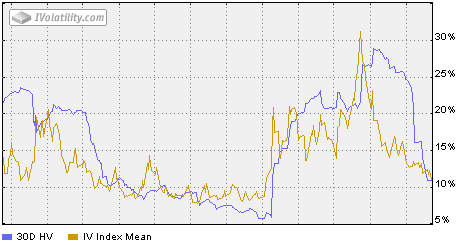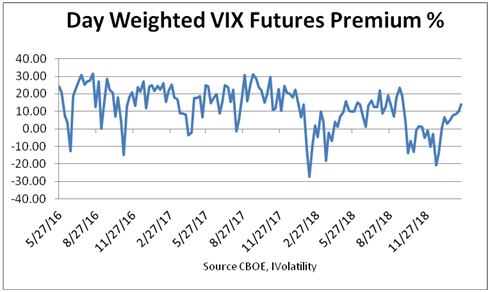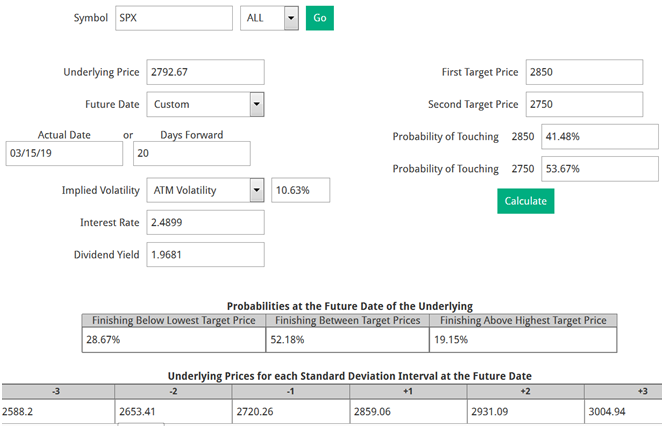
The S&P 500 Index advance continues from its December 26 th low at 2346.58, but it’s yet to exceed the December 3 rd high at 2800.18. Will it continue? Will it crash? Will the bulls get their way? Find out in our short market review, followed by strategy suggestions, created using our Probability Calculator, currently available to all Steady Options subscribers.
S&P 500 Index
CBOE Volatility Index®


Now well below the bottom of the recent range around 14 that began last October,the S&P 500 Index volatility turned even lower, as shown in the one-year volatility chart and the SPX line charts above.
Downtrending implied volatility always excites the bulls.
VIX Futures Premium
The chart below showsour calculation ofLarry McMillan’s day-weighted average between first and second month futures contracts. The premium measures the amount that futures currently trade above or below the cash VIX, (contango or backwardation) until front month future converges with the VIX at expiration.
Previously, declines below 10% and advances above 30% were unsustainable, but for the last year, premiums above 10%

With 17 trading days until the March expiration, the day-weighted premium between March and April allocated 68% to March and 32% to April for a 13.92% premium vs. 9.88% week ending February 15;into the green zone between 10% to 20% associated with S&P 500 Index uptrends, adding more support for the bullish view. If there was only one indicator available, this one would be a top contender.
Strategy
Once again, as long as the S&P 500 Index remains above the downward sloping trendline from the October 3 high and breadth continues improving, odds favor the bulls. While advancing on the upward sloping trendline from the December 26 low at 2346.58 the trendline angle at 49° seems unsustainable compared to typical longer uptrends around 30°. However, equities will likely remain well supported since few are willing to risk being short before a China trade agreement is announced when Trump and Xi meet. However, then be prepared for a "sell the news" correction now well anticipated.
Probability Calculator
This handy auxiliary tool helps determine the probability of the underlying security reaching the desired price in a selected time frame based upon either implied or historical volatility inputs.The goal is to reduce subjectivity by adding objectivity.
Our SPX example starts by setting the symbol universe to All. The other selections are: USA, Europe and Canada. The last Underlying Price 2792.67 appears automatically along with the Interest Rate and Dividend Yield.
Clicking on Future Date will list all the future options expiration dates. For this example, using Custom opens the previous selected date March 15 and then displays the number of days that can also be altered.
For Implied Volatility, ATM Volatility of 10.63% was selected assuming the current at-the-money implied volatility for this time frame is the best estimate.
Then, the First Target Price of 2850 and Second Target Price of 2750 were entered based upon our trendline estimate that SPX will continue higher.
Selecting Calculate produces the following:

Based upon this it seems like a 2845/2855 long call vertical spread is about right at 24% of the distance between the strike prices. 2845 was selected as the first strike by extending the upward sloping trendline from the December 26 low and extending it out to March 15.With SPX at 2792.67, an out-of-the-money spread cost less both in terms of the net cost and in implied volatility, since due to volatility skew out-of-the-money calls are less expensive than those in-the-money and near the money.Here they are from Advanced Options using the offer price for the buy and mid price for the sell assuming some price improvement is possible.


For actively trading underlying’s, with good options volume, the standard pricing practice is to: pay the ask for the buy, and split the difference between the bid and ask for the sell side. When option volume is low and the bid/ask prices are wide it may be necessary to use the bid on the sell side, increasing the spread cost. This is one reason for preferring underlying’s with more active volume especially for multiple leg strategies, especially butterflies with 4 legs.
The debit of 2.40 divided by the width of the spread (2845 -2855) = 10, so (2.40/10) = .24 or 24% of the distance between the strikes. This makes the vertical spread reasonably priced based upon the current location of the first out-of-the-money strike curvature (location on its call curve) and fits well with our expectations.
The out-of-the-money strike price selected is just below the first target price increasing the odds slightly from 41.48% at 2850 and both strike prices are well within one standard deviation up or down.
Since all trade plans require a SU
For other strategies, such as an Iron Condor the strike prices selected to sell should be around two standard deviations up 2931.09 or down 2658.41. For a short Iron Condor consisting of a short OTM call and a short OTM put, the objective is to place the first strikes far enough away from ATM, so as not to touch them. Two standard deviations away is a reasonable distance—any farther away and the net credit for the spreads is likely to be too small, while any closer and the probability of one leg being reached increases; meaning it will need to be closed for a loss while the second will remain open .
Summary
As the S&P 500 Index continues higher options and futures indictors continue to improve much to the delight of the bulls. Expectations seem focused on an upcoming trade deal with China that could trigger a "sell the news" correction when announced. Fortune favors the well-informed.
Written by Jack Walker. Jack Walker is the author of IVolatility.com’s Volatility Trading Digest. Jack is a former PSE options market maker and hedge fund manager. Jack has contributed to SeekingAlpha, TalkMarkets, amongst other financial news sites.
All SteadyOptions subscriptions include FREE access to IVolatility Tools ($468/year value) . The same set of tools is also available as a Standalone Subscription for non members.
What Is SteadyOptions?
Full Trading Plan
Complete Portfolio Approach
Diversified Options Strategies
Exclusive Community Forum
Steady And Consistent Gains
High Quality Education
Risk Management, Portfolio Size
Performance based on real fills
Non-directional Options Strategies
10-15 trade Ideas Per Month
Targets 5-7% Monthly Net Return
Recent Articles
Articles
Pricing Models and Volatility Problems
Most traders are aware of the volatility-related problem with the best-known option pricing model, Black-Scholes. The assumption under this model is that volatility remains constant over the entire remaining life of the option.
By Michael C. Thomsett, August 16

- Added byMichael C. Thomsett
- August 16
Option Arbitrage Risks
Options traders dealing in arbitrage might not appreciate the forms of risk they face. The typical arbitrage position is found in synthetic long or short stock. In these positions, the combined options act exactly like the underlying. This creates the arbitrage.
By Michael C. Thomsett, August 7

- Added byMichael C. Thomsett
- August 7
Why Haven't You Started Investing Yet?
You are probably aware that investment opportunities are great for building wealth. Whether you opt for stocks and shares, precious metals, forex trading, or something else besides, you could afford yourself financial freedom. But if you haven't dipped your toes into the world of investing yet, we have to ask ourselves why.
By Kim, August 7

- Added byKim
- August 7
Historical Drawdowns for Global Equity Portfolios
Globally diversified equity portfolios typically hold thousands of stocks across dozens of countries. This degree of diversification minimizes the risk of a single company, country, or sector. Because of this diversification, investors should be cautious about confusing temporary declines with permanent loss of capital like with single stocks.
By Jesse, August 6

- Added byJesse
- August 6
Types of Volatility
Are most options traders aware of five different types of volatility? Probably not. Most only deal with two types, historical and implied. All five types (historical, implied, future, forecast and seasonal), deserve some explanation and study.
By Michael C. Thomsett, August 1

- Added byMichael C. Thomsett
- August 1
The Performance Gap Between Large Growth and Small Value Stocks
Academic research suggests there are differences in expected returns among stocks over the long-term. Small companies with low fundamental valuations (Small Cap Value) have higher expected returns than big companies with high valuations (Large Cap Growth).
By Jesse, July 21

- Added byJesse
- July 21
How New Traders Can Use Trade Psychology To Succeed
People have been trying to figure out just what makes humans tick for hundreds of years. In some respects, we’ve come a long way, in others, we’ve barely scratched the surface. Like it or not, many industries take advantage of this knowledge to influence our behaviour and buying patterns.

- Added byKim
- July 21
A Reliable Reversal Signal
Options traders struggle constantly with the quest for reliable
By Michael C. Thomsett, July 20

- Added byMichael C. Thomsett
- July 20
Premium at Risk
Should options traders consider “premium at risk” when entering strategies? Most traders focus on calculated maximum profit or loss and breakeven price levels. But inefficiencies in option behavior, especially when close to expiration, make these basic calculations limited in value, and at times misleading.
By Michael C. Thomsett, July 13

- Added byMichael C. Thomsett
- July 13
Diversified Leveraged Anchor Performance
In our continued efforts to improve the Anchor strategy, in April of this year we began tracking a Diversified Leveraged Anchor strategy, under the theory that, over time, a diversified portfolio performs better than an undiversified portfolio in numerous metrics. Not only does overall performance tend to increase, but volatility and drawdowns tend to decrease: